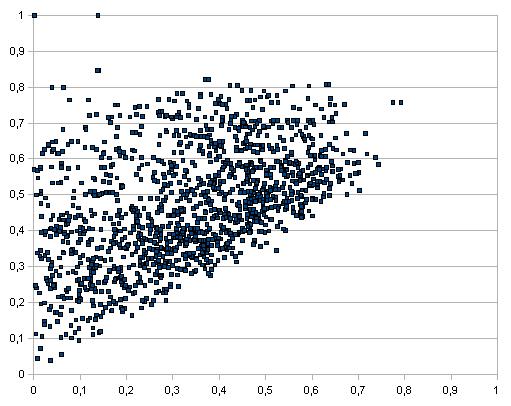How questions in Aspie-quiz are related to each other
A fundamental property of questions in Aspie-quiz is how they are related to each others. There is a general tendency for questions that have good relevance for Aspie/neurotypical scores (have a high correlation with scores) to also have high average correlation with other questions. This is shown in the following diagram which plots score correlation (x-axis) versus average correlation with other questions (y-axis) for 1,370 questions:

This property is very important for grouping questions and finding clusters in the dataset. As can also be seen above, if a question have high correlation with score, it will inevitably be correlated to about anything you want to ask. This is a common mistake in psychiatric research, and especially in research that includes Aspie traits. In fact, it is possible to group Aspie traits in about any collection of syndromes if the only criteria for traits to belong together is that they are correlated to each others.
Another way to show this is by plotting score correlation (x-axis) versus highest correlation with all other questions (y-axis):

A similar thing appears. Questions with high score correlation will seldom have low correlation with all other questions.
These findings have important implications for finding clusters. Instead of finding clusters by only looking at correlations, which will give too small clusters if questions have low score correlation and too large clusters if questions have high score correlation, another method is needed. What is needed is to compare correlations with score correlation. So, when presenting correlated questions to a specific question, one should not use a absolute correlation cutoff, but rather a relative cutoff. Using 80% of score correlation as a cutoff usually works quite well and gives good clusters regardless of a questions score correlation.
This also works in the reverse way. If a set of questions is put together, and it is found that they are highly dependent on each others (without being identical), this is an indication that these questions are measuring Aspie traits.